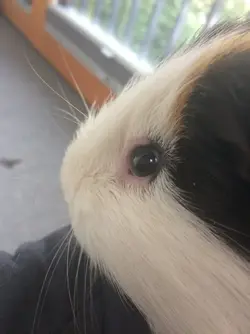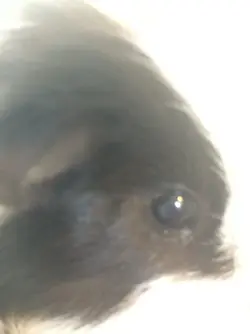Thank you!
Cataracts can develop at different speeds. At one extreme they can cover the lens in just one week while the majority will develop over a number weeks, months and years. Often, but not always, the other eye goes too in a matter of weeks or months.
It looks like your cataract has spread a bit more. The glassy blue tone is typical for a developing cataract. Over time the eye can turn white in a very strong cataract.
Guinea pig sight is thankfully not their strongest sense. Losing sight very quickly can make for a difficult transition period until the other senses take over and compensate. With a slowly developing cataract this a very gradual process. You can imagine it as thicker and thicker piece of paper being held in front of the eye.
The good news is that even piggies with fully developed cataracts on both eyes that are for all purposes blind apart from a degree of light
sensitivity can enjoy a normal and fulfilled life. The trick is to not cuddle a cataract piggy; the more you challenge it, the more of a quality of life it will have.
You can see several of my cataract piggies actually featuring in the enrichment guide. The little brindle aby, Mischief, for instance suffered from very fast developing cataracts but continued to free roam and to also free roam the garden (always supervised). I could even move their small run across the lawn, stand next to the flap and direct Mischief to find her way just by constant voice update/feedback over the distance of several years without ever touching her. But that was of course the result of several years of working together closely.
They can also use a shallow ramp as long as it is not too steep and has good grip and covering in a scent retaining material like carpet so the blind piggies follow the scent spoor. I've never had any accidents in my cataract group even though all of them used the ramp daily.
Enrichment Ideas for Guinea Pigs

